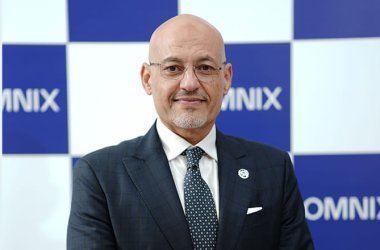Veronica Martin caught up with Ashley Woodbridge, CTO Infrastructure Solutions Group Middle East, Turkey, and Africa at Lenovo to discuss how the new HPC cluster will contribute to citizen safety and health, in what ways their collaboration will drive transformational change and the key benefits of Lenovo’s AI-enabled infrastructure solutions.

How will the new HPC cluster provided by Lenovo and Al Hathboor Bikal.ai contribute to citizen safety and health?
Firstly, one of the things we’re very excited about with this project is the sort of democratizing of access to HPC and AI. The vision for the consortium is to offer this as a service, which means you don’t need the big capital and infrastructure cost up front if you are a university graduate or if you’re a startup, and what we typically find is that’s where innovation is really happening. There are three or four smart domain experts that have the great idea to solve the next problem, but they’ve never had access to the resources. By making this consortium, we’re going to be able to give access to that and we are proud of being able to do it in a green and sustainable way.
This will be the first direct water cooling HPC cluster, which means we’re using water as the cooling medium, which is much more energy efficient. In addition, we’re even looking in the future to be able to use that waste energy from the water to use it for heating the water in the building. We are also looking at how we can innovate to use the hot water to cool down the buildings. Once we have the data, AI helps to solve those problems. Whether it’s from looking at how we can provide better child come outcomes, whether it be from how we can provide safety and security through making sure we understand problem intersections during school drop off times and all these sorts of things. Getting access to the data, making the right people be able to build the models and the intelligence will deliver naturally better citizen services and better safety for the whole world.
What makes the data centre at Sharjah Research Technology and Innovation Park unique in terms of sustainability and power source?
The direct water cooling is a key element, but also what we are very proud of is when we engineer these systems from the ground up, we want to do it in a sustainable way. When we’re making the components, we make sure we use the minimal ones and we use the most energy efficient power supplies and remove anything that’s not required, so there was a lot of consideration taken throughout the process.
This culminates in sharing the vision of using water cooling technology, which is a first in the UAE. It really can’t be underestimated how important that is. Once one organization sees that water cooling technology works and it can solve problems, then more people will be willing to try it. We would love to see all data centres using water cooling technology just cause it’s so much more efficient. As we have very hot summers our region, every degree makes a difference.
In what ways will the collaboration between Lenovo and Al Hathboor Bikal.ai drive transformational change in citizen welfare and health?
We have our AI innovators program and four labs around the world, which are purposely built to set up these consortiums, so lot of what we are bringing to them is access to those experts. When it comes to genetics and DNA testing, we have subject matter experts that are recognized globally that now through the consortium we can give access to help support building that capability locally. There’s a disease called sickle cell anaemia, which is very specific to the Gulf community. Just like you do a PCR test, they want to eventually get to the place where they can do carrier tests for expectant parents to be able to look for these diseases that have been underrepresented in the region.
Typically, the data sets have all been American, Anglo-Saxon, or European and been looking for diseases that are not relevant here. AI and setting up the consortiums aren’t easy, so we bring that experience of how to build these consortiums, how to invite research and technology partners, how to get universities involved. An example of this would be what we’ve done with the city of Barcelona.
In Barcelona, they have one of the world’s HPC Cluster, and we were able to work with them to have the city as a customer. We’ve done a lot of innovation around looking how we can use augmented reality to help people with vision impairment to be able to detect in real time what’s around them. For example, if they’re heading towards a light, they can be told that the traffic light’s red, please wait, there’s a car coming from your right and from your left sort of thing. That sort of collaboration works well, and we want to replicate it here.
What specific services and support will Lenovo provide to Al Hathboor Bikal.ai in terms of HPC hardware, software, and operational management?
The whole infrastructure from a HPC point of view comes from Lenovo, but obviously the management and operations of that and making sure it’s performing in an optimal manner is all a part of what we call true scale, which is what we’ve deployed here. It is ultimately a managed service to be able to make sure that not only does the investment works best on day one, but throughout its whole lifetime journey where it’s continually working with the rest of the consortium to tweak, optimize, upgrade, and make sure any innovations in the software space are able to be deployed and work on the solution. That’s where we leverage our AI innovators program globally to constantly be in touch with the team on the ground to make sure that it is working in full strength.
How can the HPC cluster situated at SRTIP enhance citizen health and safety within the emirate of Sharjah through data processing, analysis, and real-time monitoring?
We see a lot now of what we call edge AI. Traditionally what you’ve always seen is that AI has been focused on office parks, buildings and now, with 5G and better battery technology, we’re able to put sensors across the whole city. We are also starting to see a big trend of using computer vision. Where before, if you had to have 10,000 sensors to monitor something, it became cost prohibitive and very challenging, but now, as the technology in cameras is so good, we all see it in our phone.
One camera can monitor 10,000 different data points and we’re not using the cameras as CCTV or security, but to turn vision into data points. From an airport safety point of view, you can monitor if luggage is left behind, if kids are detached from their parents in shopping centres and track where that person is. We can do lots of different use cases in a very efficient way. All those AI models are built on HPC and then are pushed to these edge locations.
There is a life cycle around the design and engineering done on HPC, making it efficient, packaging it, and then being able to push it all over the city. And having it close to the use case means that if you are doing gas detection leakage or something like that, you can detect it instantly. If you are looking for a fire, you can now do it instantly because it’s all pushed out to the field.
What are the key benefits of Lenovo’s AI-enabled infrastructure solutions and how will they be deployed across various sectors in the UAE, such as education, R&D, retail, and oil & gas?
The use cases vary, but what’s obviously very important is the overall ROI. If you think of large HPC clusters, energy normally becomes the largest part of the cost. If you were thinking broadly and had a 5 million HPC project, probably 3 million of that would be the ongoing maintenance, management, cooling, and energy. One of the things that we are very proud of is making sure that we make that as efficient as possible. For example, how do we make the clusters easy to manage? How do we reduce the operational overhead of IT staff having to keep the system up?
We do a lot of work on automation to be able to have the system self-managing itself and efficiently choose which nodes in the cluster are the right ones to run on based on the performance profile. All that innovation from a hardware and software piece opens new use cases that probably couldn’t be done before because they were just too expensive.





